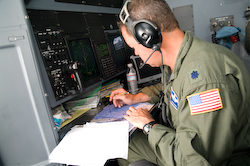|
Cyberflight Entoute to the Storm
|
|
| |
|
|
| |
| As we fly over the Gulf of Mexico toward Dennis,
the weather is beautiful! It's an odd feeling, knowing that what
awaits us is quite different. In Pilot Training, we were always
told to stay far, far away from thunderstorms, now they want us
to go right through them. We remind ourselves that we all
volunteered for this job!
|
 |
|
|
| Hurricane Dennis is nearly 300 miles away, so it
will take only an hour and a half for us to get there. Let's
tour the plane!
As you walk forward in the cargo compartment
of this rather large plane, you find two very specialized
equipment pallets at the front of the compartment.
|
|
 |
On the left side of the cargo compartment is the ARWO (Aerial Reconnaissance
Weather Officer) and the equipment that the ARWO uses to
record flight level data from the aircraft's weather
instruments as well as the satellite transceiver to
communicate our data to the Hurricane Center.
A recent addition to the ARWO's arsenal of
weather equipment is the SFMR (stepped frequency microwave
radiometer) that allows us to sample wind speed at the ocean
surface as we fly along above the ocean at 5,000 or 10,000
feet. From here the ARWO is able to monitor the data, guide
the pilots to the center of the storm using the wind speed
and direction outside the aircraft, and make the fix when we
pass through the center of the storm. |
|
| On the right side of the cargo
compartment you'll find the weather reconnaissance
loadmaster along with the equipment used to launch a
dropsonde out of the aircraft, collect data transmitted
back to the airplane from it, analyze and format the
data, and send it to the ARWO for transmission to NHC.
The dropsonde is a small weather
instrument that sends temperature, humidity, barometric
pressure, wind speed, |
 |
|
| wind direction, and
position back to the aircraft twice each second during
its 2500 foot per minute descent to the ocean surface.
This instrument allows us to collect important
information about a storm such as maximum winds in the
eyewall and surface pressure at the center of the storm.
|
|
 |
As you
climb the stairs to the flight deck you find the
navigator at the back of the cockpit. The navigators job
is two-fold in a tropical storm mission. The first, as
you might well imagine, is to plot our course to and
from the storm as well as plot our alpha pattern (see
below) as we make multiple passes through the center of
the storm.
The second job of the navigator is to
help keep us all alive by monitoring the radar, keeping
us clear of any |
|
| severe thunderstorm cells
and severe turbulence, and having an escape vector handy
at all times in the even that the pilots feel we're in
weather too heavy to safely navigate. |
|
| An "alpha pattern" is the
flight path we typically follow as we collect data in a
tropical storm.
To help you visualize what an "alpha
pattern" looks like, think of cutting a diagonal across
the storm, 105 nautical miles on either side of the eye.
Then, it's a simple case of always making left turns, so
the aircraft doesn't have to fight the winds that are
swirling counter-clockwise. Notice that after two passes
through the eye (fixes), the winds in all four quadrants
have been measured. At this point, the plane would
typically continue the alpha pattern, making two more
fixes before heading home. |
|
 |
 |
|
At the front of the
cockpit sits our two pilots. The difficult task of
flying a large 4 engine cargo aircraft into weather that
every pilot is taught to avoid at all costs falls upon
these two crew members.
While we all work as a team to
accomplish the mission, it's the skill of these two
people that gets us there and back safely. |
|
| As you look out the front
windshield at the clouds thickening ahead of the
airplane, the loadmaster comes up to let you know we are
about to enter the storm.
You head back to the cargo compartment
to take your seat, wondering if coming along on this
ride was such a good idea after all! |
|
 |
|
|
| |
Into the Eye |
 |
|
|
|
|
|
   
|